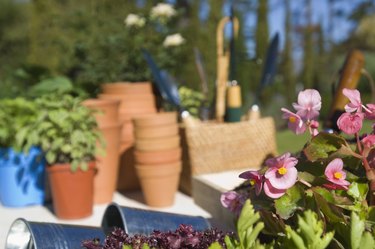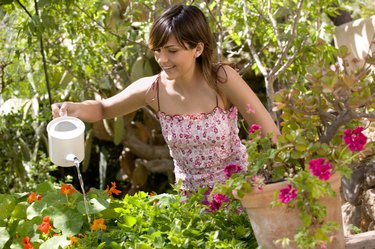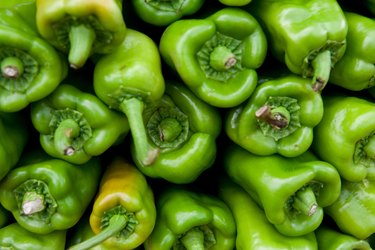
Growing your own bell pepper plants can be a rewarding endeavor. Watching the plants begin to grow tall and blossom is a thing of beauty. Watching the fruits of your labor begin to emerge from the blossoms produces a feeling that is indescribable. Bell pepper seeds are available in a number of colors and varieties. They each mature at different times, but each pepper starts out green before turning red, yellow, purple or orange when they ripen. Care and maintenance of the plants are the same no matter what variety or color of pepper you are growing.
Watering Bell Pepper Plants
Video of the Day

Keep bell pepper plants well watered—especially when they are beginning to blossom. Conditions that are too dry will cause the young plants to go into stress, wither and die. Plants require more water when they are producing fruit than when they are just growing and maturing. Give them an inch of water per week before they begin to blossom and increase this amount to 1 1/2 inches or more for hotter spells and when fruit production begins. Place a plastic drinking cup under your sprinkler to measure how long it takes to add one inch of water to your garden. If bell peppers and other pepper varieties are not watered well enough while producing fruit, the peppers themselves will be small and have a bad flavor. Water the rest or your garden as much as you water your bell pepper plants. Watering methods include watering cans, watering hoses, hose-end sprayers or sprinklers and sprinkler systems. Sprinkler systems can be set to automatically water your garden as often as you would like, and at any time of the day. Timers are also available at home improvement centers that can be hooked directly to a garden hose if you do not have a sprinkler system installed in your garden. Place the hose where you would like the water to go so water will not be wasted.
Video of the Day
Bell Pepper Plant Care

Even though bell pepper plants can be purchased as starts in most areas of the United States, many gardeners prefer to cultivate their own pepper plants from seeds. Peppers are less expensive to grow from seeds once you have all of the tools and ingredients necessary to begin growing indoors. A simple indoor greenhouse and peat moss discs are all you need to start your garden in the early spring, and these items are available in many home improvement stores. Purchase a balanced fertilizer to add to the soil when it is time to transplant your starts outside. A balanced fertilizer contains the same percentage of nitrogen, phosphorus and potassium displayed on the bag as 16-16-16, 12-12-12 or 10-10-10. Add 2 to 3 inches of compost to the garden soil and till the compost into the soil well before planting your garden. This is essential for areas with heavy clay soil and in dry climates. Add fertilizer to the soil three to five days before planting. If you purchase starts from a store, and if they come in a peat pot, cut the bottom of the pot off and loosen the soil in the bottom of the pot to expose the roots. This will encourage them to spread as the plant begins to grow. Bury half of the start under the soil so the start will be stronger as it grows. Fertilize monthly throughout the growing season.

